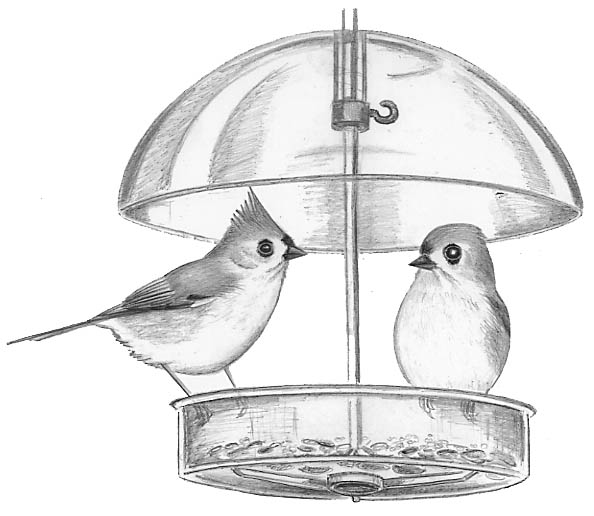
Dear Bird Folks,
After five years of looking, I have finally been able to figure out which bird has been making the constant “dee-da, dee-da, dee-da” call in my yard. It’s the Tufted Titmouse. The book claims their call is “peter, peter, peter” but I don’t hear it that way. Anyhow, I would like to know why this bird is constantly giving that call. Is it a lonely bird trying to attract a mate or is it merely announcing its territory? After all these years of looking for it, now I need to know what is this bird saying?
– Sal, Osterville, MA
You picked the right guy, Sal,
You certainly have asked the right guy this question. I’m one of the few people on Cape Cod who can speak fluent titmouse. It’s something that I picked up in school and have since honed my skills by playing those Berlitz conversational titmouse tapes on my drive to work. Most of my friends told me that it was all a silly waste of time, but I knew this day would come. Now, who’s laughing?
I would bet that just about anyone living in the eastern U.S. has heard the distinctive song of the Tufted Titmouse. I would also bet that most people don’t even realize that they have heard one. Like the sound of the spring peepers and your neighbor’s riding lawnmower, the titmouse’s constant song is the soundtrack of warm spring days; yet, most of us pay little attention to it. One day I heard a construction worker whistling this little bird’s song as he hammered away. The ubiquitous song had gotten stuck in the guy’s head. I’m sure the guy had no clue that he was whistling the song of a titmouse, and even if he did know, you can be sure he wouldn’t admit it.
Titmice actually have a good assortment of calls and songs. More than once I’ve spent the day trying to find the “new” bird, only to find that once again I’ve been fooled by the calls of the multilingual titmouse. But by far their most commonly heard sound is their signature “peter, peter, peter,” song. Or, as you say, Sal, “dee-da, dee-da, dee-da.” Actually, I like your interpretation better. Even birds know that putting an “R” at the end of a word is a waste of time.
Both of your suggestions are the probable reasons for the bird’s constant singing. Male titmice use their song to announce their territory and to advertise for a mate. It is thought that the bird that sings the longest and loudest has the best chance of attracting a female. Why would a female actually care if its mate is a good singer? One theory is that a male that has the time and energy to sing all day, must be fit and would be a good provider. Less vocal birds have little time to sing because, it is thought, they aren’t as efficient at gathering food and must spend too much of their time foraging. When those quieter birds finally have time to sing, they often sing with their beaks full and the ladies hate that. Take it from me.
Besides a large repertoire of songs and calls, the titmouse also has a few non-vocal means of communicating. The crest, or tuft, of the Tufted Titmouse, comes in handy when the bird wants to show its status in the flock. In the fall and winter titmice travel around in small groups. A dominant bird will land on a food source with its tuft fully erect, telling the others to back off. The subordinate birds, not wanting to cause trouble, meekly approach the food with their tufts totally flat, looking like a dog that has been caught sleeping on the couch. Last week a guy sent me a photo of just such a titmouse. The bird in the picture had a completely rounded head and the guy wanted to know where the bird’s tuft had gone. I wrote back and told him that his photo was not of a Tufted Titmouse, but was a picture of the less popular Comb-over Titmouse. I think he believed me.
Like chickadees, titmice love to come to our feeders for nuts and sunflower seeds. Also, like chickadees, titmice use birdhouses and old woodpecker holes for their nests. However, titmice prefer to nest in locations that are rather wooded. They are less likely to use a birdhouse in an open backyard. Titmice would also rather nest higher off the ground than most other cavity nesters. For years I’ve been telling people to place their nest boxes on posts, in the open, and only about five feet off the ground. Such a location is not desired by titmice, which means the people who listened to me probably never got nesting titmice. Oops!
I’m glad you were finally able to track down the “dee-da, dee-da, dee-da” bird, Sal. Now I have to go track down all those people who I told to put to their nest boxes on short posts and let them know that they probably won’t attract Tufted Titmice. The best they can hope for are chickadees, bluebirds, or wrens. Hopefully they won’t end up with any of those Comb-over Titmice. Those birds are kind of creepy.